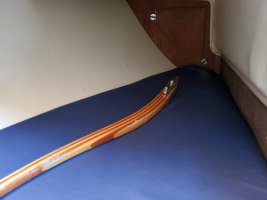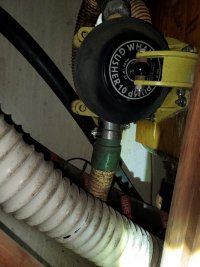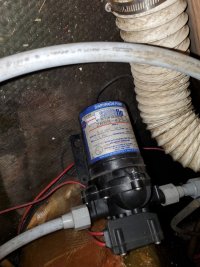+1 would love to see more photos. Roger is sending me a bunch from his, too; we're only 10 hull numbers apart.Alan, I try, I'll see what I can find I have so many photos.
Did you move your sink to another location? Mine is right under the bulkhead.
+1 would love to see more photos. Roger is sending me a bunch from his, too; we're only 10 hull numbers apart.Alan, I try, I'll see what I can find I have so many photos.
Thanks, Roger - looks nice and clean down there. I'm going to make a template to cut a new one because I will have need to crawl across there and I don't want to break my fuel tank. Is that romex wire to the top left feeding AC somewhere?My prior recollection that yours looked like mine (Post #6) was wrong. You were right that there used to be a shelf there:
My blower (which I removed quite some time ago) was located underneath the forward part of the quarterberth. On my boat there is an access hatch to it.Thanks, Roger - looks nice and clean down there. I'm going to make a template to cut a new one because I will have need to crawl across there and I don't want to break my fuel tank. Is that romex wire to the top left feeding AC somewhere?
A few questions for any of you...because I haven't had time to trace all this stuff down. The big blue hoses go to the cowl vents close to the stern, right? Are these somehow integrated with the blower? Where is/are the fan(s) located for the blower? I have a breaker for one, but I don't really hear anything when I turn it on.
I'm familiar with the arguments for removing the blower. Did you remove the hoses to the cowls, too?My blower (which I removed quite some time ago) was located underneath the forward part of the quarterberth. On my boat there is an access hatch to it.


No, it's not that hatch. That one is located at the aft end of the QB. The hatch I'm talking about is located underneath the cushion on the fiberglass liner at the forward end of the berth.I'm familiar with the arguments for removing the blower. Did you remove the hoses to the cowls, too?
I think I know of the hatch of which you speak. The same one you that gives you access the cockpit gusher pump?
Are there two blowers? If not, what does the cowl on the port side do?
View attachment 37732
View attachment 37733
Not the one by the battery compartment, right? I seem to recall one just a little further down. I'll be out there tomorrow, I'll look then. I snagged one of those whiz-bang inspection cameras that can go in tight places. I'm hoping it will be better than the blind shot with the cell phone.No,
No, it's not that hatch. That one is located at the aft end of the QB. The hatch I'm talking about is located underneath the cushion on the fiberglass liner at the forward end of the berth.
There are not two blowers. I removed mine because when I switched it on it was noisy (maybe a bad bearing?) and I don't believe it's necessary for a diesel. Also, it opened up some needed space on my electrical panel.
I have a Ronstan traveller that may be screwed into the coachroof as Alan says. I'm not sure if that's the original, but I haven't noticed anything worrisome about it. Maybe it's because it has not had to handle more than 25 knots holding a reefed main.That's sharp looking. I'll have to remember to watch my traveler to see how much it flexes when I go out this Spring. However right now, I think that $600 needs to be spent in other places.
Yes, it's near the battery compartment. I believe there are two round hatches there. I forget which of the two it is but it was inside of one of them and easily accessed.Not the one by the battery compartment, right? I seem to recall one just a little further down. I'll be out there tomorrow, I'll look then. I snagged one of those whiz-bang inspection cameras that can go in tight places. I'm hoping it will be better than the blind shot with the cell phone.
I believe the Ronstan was the OEM hardware. Flexing notwithstanding, I didn't much care for it anyway. The Garhauer setup operates as smooth as butter. But if what you've got works for you and you aren't observing any objectionable flexing of the sea hood, then I guess if it ain't broke....I have a Ronstan traveller that may be screwed into the coachroof as Alan says. I'm not sure if that's the original, but I haven't noticed anything worrisome about it. Maybe it's because it has not had to handle more than 25 knots holding a reefed main.
I have so far been fortunate enough and lazy enough not to have figured out what anything in that photo is! (And romex is a new word to me.) The white-coated wire in the upper left is DC to the cockpit multi-pin plug that powers my Simrad Tillerpilot. That red wire looks like it may go over to the starboard side way aft, in which case I suspect it is for the shore power AC current.Is that romex wire to the top left feeding AC somewhere?
When I looked at the E26 for the first time --- buying my first and only boat --- I was shocked to see the traveler on the coachroof as, in my innocence, I had never seen a mainsheet run to anything but the end of the boom. The 38' sloop I crossed the North Atlantic in had the traveler right there in front of the companionway as DaveE26 does, and that seemed the right place for it. Once on galley duty in a heavy sea, I emerged from below with a pale face and an odd expression, and the first thing the skipper did was to release the traveler to get it out of the way. Then he handed me a bucket.DaveE26's setup also looks pretty nifty, if one doesn't mind the placement of the traveler on the bridge deck.
Ah-ha. It kind of looks like romex, which is another name for common AC electrical wire (it's a brand name - kind of like Kleenex).I have so far been fortunate enough and lazy enough not to have figured out what anything in that photo is! (And romex is a new word to me.) The white-coated wire in the upper left is DC to the cockpit multi-pin plug that powers my Simrad Tillerpilot. That red wire looks like it may go over to the starboard side way aft, in which case I suspect it is for the shore power AC current.
It's the aft-most hatch in the quarter berth. I looked in yesterday and saw where the blower fan used to be along with the old ratty hoses, but no fan. Guessing it was a casualty of the flood. However, I did find this:Yes, it's near the battery compartment. I believe there are two round hatches there. I forget which of the two it is but it was inside of one of them and easily accessed.

The vent cowls port and starboard will provide some ventilation into the engine compartment. As for exhaust fumes inside the engine compartment, you should not have those unless you have a leak somewhere.It's the aft-most hatch in the quarter berth. I looked in yesterday and saw where the blower fan used to be along with the old ratty hoses, but no fan. Guessing it was a casualty of the flood. However, I did find this:
View attachment 37761
So, I guess that explains the "standard" faucets that were installed at the two sinks. Now to trace it back and figure out how it hooks into the fresh water tank.
So, I know the blower is less necessary for diesel engines from a combustion perspective, but isn't an exhaust fan still a good idea to not only get air to the engine but to help pull any stray exhaust fumes from the compartment?
While an exhaust blower may not be "required" for a diesel installation, it's a good idea. It will remove heat and the odor of crankcase blow-by smells from the engine compartment. Many engines had their crankcase vent (small hose from a fitting on the top of the valve cover) redirected to the intake air cleaner by the 90's and lots of owners of earlier engines made this upgrade. I did this on my previous '88 Universal diesel, and my replacement Betamarine has this little bit of plumbing as standard equipment.So, I know the blower is less necessary for diesel engines from a combustion perspective, but isn't an exhaust fan still a good idea to not only get air to the engine but to help pull any stray exhaust fumes from the compartment?
Just curious, Loren, but do you run your blower whenever you are running your engine? And if so, is the blower rated for continuous operation?While an exhaust blower may not be "required" for a diesel installation, it's a good idea. It will remove heat and the odor of crankcase blow-by smells from the engine compartment. Many engines had their crankcase vent (small hose from a fitting on the top of the valve cover) redirected to the intake air cleaner by the 90's and lots of owners of earlier engines made this upgrade. I did this on my previous '88 Universal diesel, and my replacement Betamarine has this little bit of plumbing as standard equipment.
No way should a boat have "stray exhaust fumes" inside the boat.
Yes, and presumably yes. For 25 years. I have replaced one blower. Presently we are installing a new blower as part of the re-fit.Just curious, Loren, but do you run your blower whenever you are running your engine? And if so, is the blower rated for continuous operation?
Dave, this is the starboard blower in my boat (see photo). It is right near the battery compartment. It makes a really loud, squeaky noise (another project). I am not sure how necessary these are for a diesel.Not the one by the battery compartment, right? I seem to recall one just a little further down. I'll be out there tomorrow, I'll look then. I snagged one of those whiz-bang inspection cameras that can go in tight places. I'm hoping it will be better than the blind shot with the cell phone.
Loren - what does this look like? I'm pretty new to diesel engines and all of their parts. Is this the same as the head-to-air intake? It's the only part on my engine that mentions a breather.It will remove heat and the odor of crankcase blow-by smells from the engine compartment. Many engines had their crankcase vent (small hose from a fitting on the top of the valve cover) redirected to the intake air cleaner by the 90's and lots of owners of earlier engines made this upgrade. I did this on my previous '88 Universal diesel, and my replacement Betamarine has this little bit of plumbing as standard equipment.
